Who Joined?
Young men
Men from Tennessee joined either the Confederate or Union armies. Most had not even been men for long. The average age of a Civil War soldier was 25 years old.
Some were just young boys. One such boy was Johnny Clem. He was only ten years old when he joined the 22nd Michigan Infantry as a drummer boy. He saw action at Shiloh, Stones River, and Chickamauga. He was even captured one time, but survived the war and lived until 1937.
Volunteers and draftees
Many soldiers were rural farmers or tradesmen. Most did not even own slaves. But the primary reason of joining for many volunteers was a desire for adventure, excitement, and glory. As soon as they saw their first battle, and how gruesome war was, they were not as happy to be at war.
As the war became bloodier, less and less men signed up to fight. Volunteers considered themselves “as civilians temporarily in uniform to do a necessary job as quickly as possible so they could return home,” according to historian James McPherson.
Eventually, the Confederate army was forced to start a draft in 1862. A draft is when men are ordered to join the army. This meant that most able-bodied men in Tennessee between the ages of 18 and 35 had to fight in the war.
The draft was very unpopular. First because it made men fight against their will. And second, the law let wealthy men that owned 20 or more slaves avoid the draft. That meant they did not have to fight if they did not want to. This led to some bad feelings. A farmer in North Carolina complained to his wife “this is a rich man’s war. But the poor man has to do the fighting.”
Wealthy men
Owners of large plantations, businessmen, community leaders and their sons often considered themselves as occupying a privileged position in society. Because they were leaders in the business world and society, they considered themselves as the natural leaders of any military group.
Service in the army was part of their duty to society and country. They saw the northern army as a real threat to their homes and income.
Planters, lawyers and merchants used their personal influence to persuade young men to enlist in local units. Former Nashville mayor Randal McGavock led the 10th Tennessee unit he helped organize.
“My whole heart is in the cause of the Confederacy, because I believe that the perpetuity of Republican principles on this Continent depends upon our success,” he wrote in his diary on May 9, 1862.” McGavock later died in battle.
Read about another wealthy Tennessee man who joined, Edmund Cook.
African American men
African American men also joined the army. With the Emancipation Proclamation in 1863, the Union army could officially recruit black troops in Tennessee. Black soldiers from all three Tennessee regions helped form the eight artillery, 22 infantry, and one cavalry units which made up the United States Colored Troops stationed in Tennessee.
Despite their services many black soldiers continued to face racial discrimination. In a photograph of the officers of the First Regiment, Tennessee Infantry of African Descent, (shown on this page in the small photographs--click image to enlarge) notice that not one of the officers is an African American.
This is because all colored troops were commanded by white officers, some of whom resented their command of black soldiers. Sometimes black soldiers did not receive the same pay nor were not granted similar leaves as white soldiers.
But many white soldiers and officers learned to respect their fellow black soldiers. After the Battle of Nashville, a private in the 89th Illinois wrote: “whites and blacks charged together and they fell just as well as we did…I have seen a great meny (many) fighting for our country. Then why should they not be free.”
Women:
A few women dressed in men’s clothing were able to pass as men with the troops. During the Stones River battle, two wounded soldiers were dis-cover-ed to be women when they were treated. Frances Hook, who went by the name of Frank Martin, served with the 2nd East Tennessee Cavalry in the Union Army.
Other women followed husbands to the camp, although one soldier said those women “go like men [They] sleep in tents like another boy.”
For more information:
Johnny Clem
Emancipation Proclamation
Women who served as soldiers
Picture Credits:
- Photograph of the Ammon brothers, Benjamin and Raford, who joined the 1st Tennessee Heavy Artillery Company together. After the unit surrendered at Vicksburg in July 1863, Raford re-enlisted in the 18th Tennessee Cavalry Regiment. He later lost an arm at the Battle of Brice's Crossroads, Mississippi. Courtesy of the Tennessee State Library and Archives
- Tintype, photograph, of four Union soldiers in the 8th Tennessee Calvalry. They are identified, in no particular order, as Albert Owen, James Cheatham, Samuel Mullins and Andrew Potter. Tennessee State Museum Collection, 92.93.25
- Tintype, photograph, of four Union soldiers in the 9th Tennessee Calvalry Volunteers. Identified left to right are James Hix, James Ratliff, John Leab and David Barnes. This tintype was in an album compiled by Capt. George Grisham of Jonesboro. Tennessee State Museum Collection, 92.93.21
- Tintype, photograph, of James Griffith of Alexandria, TN. Griffith is listed as a sergeant in the 5th Tennessee Cavalry, U.S.A. Tennessee State Museum Collection, 1997.135.1
- Drawing of women saying goodbye to Confederate soldiers leaving for the war. Artist is unknown. From Battles and Leaders
- Photograph of a Confederate officer, probably from Tennessee. Tennessee State Library and Archives
- Print of the painting, "Leaving Home," by Gilbert Gaul. Artist's interpretation of a young Confederate soldier leaving his home to go and fight. The print is copyrighted in 1907 by Southern Art Publishing Company
- Four images together, from the top left, clockwise: Ambrotype, photograph, of Uriah Peeples of Nashville who was a private in the 20th Tennessee C.S.A. 1997.148.1; ambrotype of an unknown Union soldier, 73.111; African American Union soldier, 76.197B; and John Edward Runnels with the 41st Tennessee Infantry, C.S.A., 83.71.7; all from the Tennessee State Museum Collection
- Photograph of Confederate Lieutenant Henry Cook, Company D, 1st Tennessee Infantry, C.S.A. and later TN 55th Infantry. The photograph was taken in 1861 when he was 17 years old. He was injured at Stones River in 1862, and later captured in Virginia in 1864. After the war, Cook served as Chief Judge of Williamson County. Tennessee State Library and Archives
Civil War and Reconstruction >> Civil War >> Soldiers Life >> Who Joined?
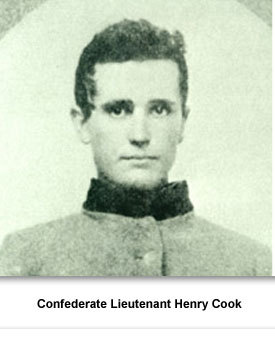
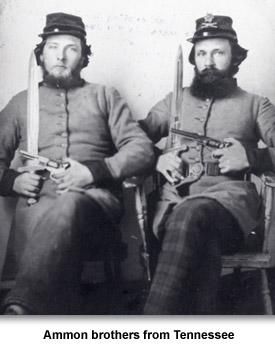
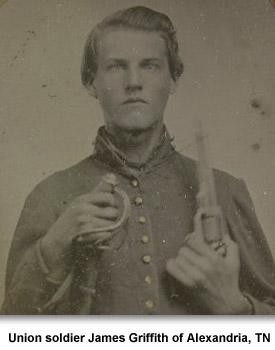
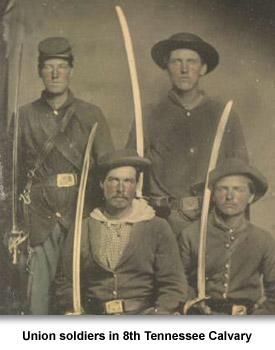
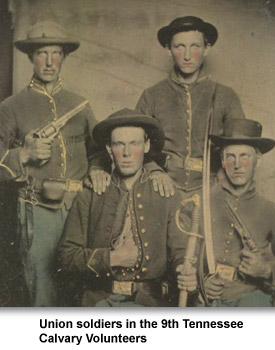
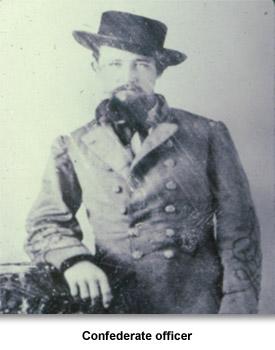
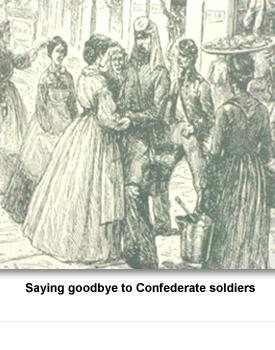
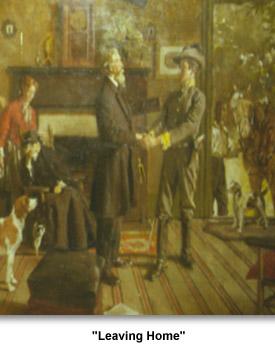
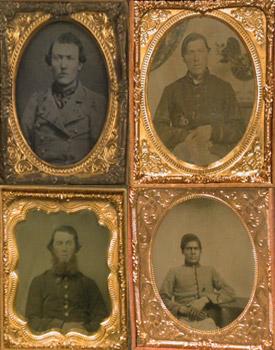
 Sponsored by: National Endowment for the Humanities
Sponsored by: National Endowment for the Humanities